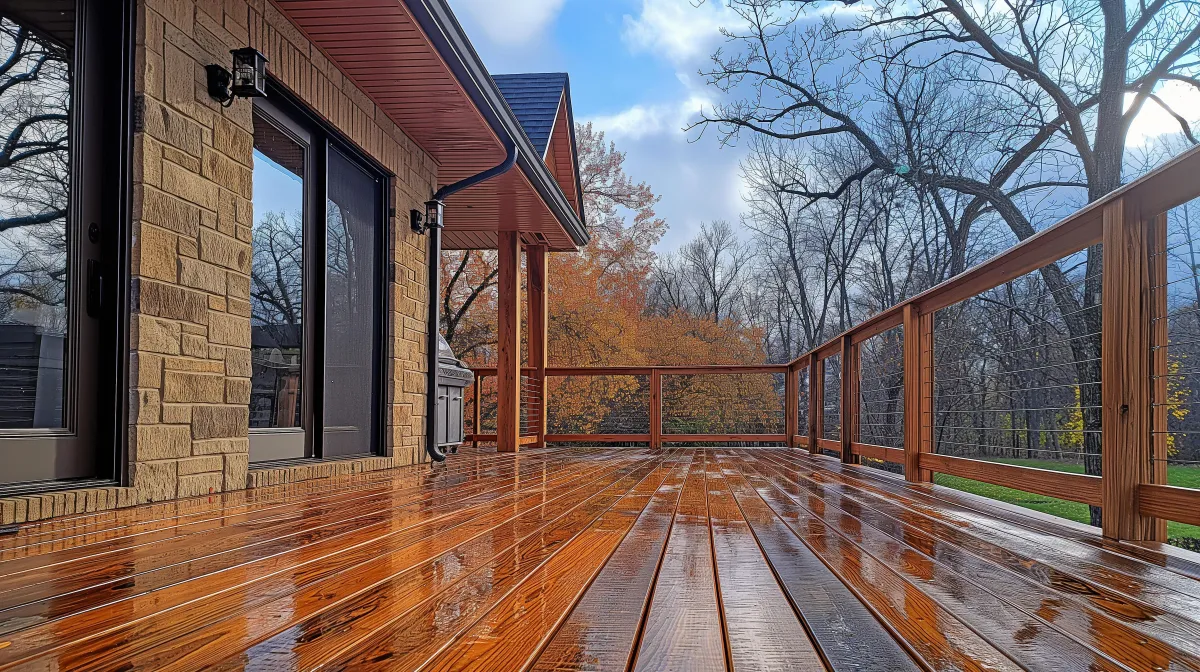
How to protect decking from the weather?
A beautiful deck can be a fantastic extension of your living space – a place for relaxing, entertaining, and enjoying the outdoors. However, being constantly exposed to the elements, your wooden deck faces a barrage of challenges from sun, rain, snow, and fluctuating temperatures, especially here in New England. Without proper protection, your investment can quickly deteriorate, leading to costly repairs or even replacement. So, how can you effectively shield your decking from the weather and keep it looking great for years to come?
Why protect your wood decking?
Wood is a natural material, and like all natural materials, it's susceptible to environmental stressors. Here’s what your deck is up against:
Moisture (Rain & Snow): Constant exposure to water can cause wood to swell, warp, cup, and rot. It also creates a hospitable environment for mold and mildew growth.
Sun (UV Rays): The sun's ultraviolet rays break down wood fibers and lignin (the natural glue that holds wood fibers together), leading to graying, fading, and weakening of the wood. It can also cause the wood to dry out and splinter.
Temperature fluctuations: The expansion and contraction of wood due to changing temperatures can cause cracks and splits.
Ice: Water freezing in the cracks and pores of the wood can expand and cause further damage.
Debris: Leaves, dirt, and other organic matter can trap moisture against the wood surface, promoting rot and mildew.
Protecting your deck isn't just about aesthetics; it's about preserving its structural integrity and ensuring its longevity and safety.
How to protect a wood deck from water?
Water is arguably wood's biggest enemy. Here’s how to fight back:
Apply a Water-Repellent Sealer or Stain: This is your first line of defense. High-quality sealers and stains create a barrier that prevents water from penetrating the wood. Look for products specifically designed for decks that offer water repellency. Oil-based stains often provide deeper penetration, while water-based options are easier to clean up and have lower VOCs (volatile organic compounds).
Ensure Proper Drainage: Make sure your deck is built with a slight slope away from the house to allow water to run off. Gaps between deck boards also help with drainage and ventilation.
Clean Regularly: Don't let water pool. Sweep away standing water after rain.
Reapply Protection Periodically: Sealers and stains don't last forever. Depending on the product and your deck's exposure, you'll likely need to reapply every 1-3 years.
How to protect a wood deck from the sun?
The sun's UV rays can be brutal. To minimize sun damage:
Use UV-protectant finishes: Many deck stains and sealers contain UV inhibitors that act like sunscreen for your wood, slowing down the graying process and protecting the wood fibers. Pigmented stains (semi-transparent or solid) offer more UV protection than clear sealers because the pigments block the UV rays.
Consider lighter stain colors: Darker stains absorb more heat, which can make the deck hotter and potentially accelerate drying and cracking. Lighter colors reflect more sunlight.
Provide shade: If possible, use umbrellas, awnings, pergolas, or nearby trees to reduce the amount of direct sunlight hitting your deck, especially during the hottest parts of the day.
How to protect the wood deck from ice and snow?
Winter weather in Massachusetts can be tough on decks:
Clear snow promptly: Don't let snow accumulate and sit on your deck for extended periods. Use a plastic shovel or a stiff broom to avoid damaging the wood surface. Avoid using metal shovels, which can gouge or scratch the wood.
Avoid salt and chemical de-icers: Many chemical de-icers can be corrosive to wood and fasteners, and can also damage the deck's finish. Salt can also dry out the wood. If you need traction, use sand sparingly.
Ensure a good seal before winter: Make sure your deck is well-sealed before the winter weather hits. This will help prevent water from melting snow and ice from seeping into the wood.
How to protect a wood deck from debris?
Leaves, pine needles, dirt, and other organic matter can trap moisture and promote mold, mildew, and rot:
Sweep regularly: Make it a habit to sweep your deck clean, especially during the fall when leaves are abundant. Pay attention to corners and areas under furniture or planters.
Clean between boards: Use a putty knife or a specialized tool to remove debris from between deck boards to improve drainage and airflow.
Trim overhanging branches: This will reduce the amount of leaves and other debris falling onto your deck and also minimize shade that can slow drying.
Benefits of deck inspection
Regularly inspecting your deck, at least once a year (spring is a great time), is crucial for catching potential problems early before they become major issues. A thorough inspection should include:
Checking for loose or rotted boards: Probe any suspicious areas with a screwdriver. If it sinks in easily, you likely have rot.
Inspecting railings and stairs: Ensure they are secure and stable.
Looking for loose or corroded fasteners: Tighten any loose screws or replace corroded ones.
Examining the finish: Look for signs that your sealer or stain is wearing thin and needs reapplication.
Checking the ledger board: This is where the deck attaches to your house. Ensure it's properly flashed and there are no signs of rot or water damage.
Looking for a deck inspection near me? Contact Pessotti Construction
Keeping your deck protected from the weather requires consistent effort, but it's well worth it to maintain its beauty, safety, and value. If you're unsure about the condition of your deck, need repairs, or are considering building a new one, Pessotti Construction can help.
We offer professional deck inspection, repair, and construction services throughout Massachusetts. Our experienced team can assess your deck's needs and recommend the best solutions to protect it from the elements and ensure it remains a wonderful outdoor space for years to come. contact us today for a consultation!
